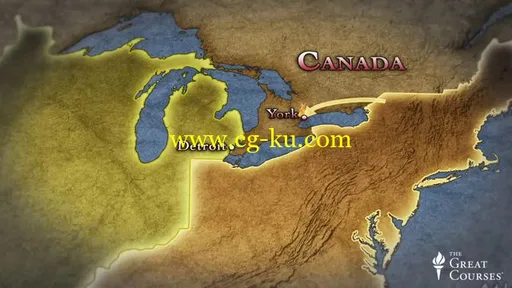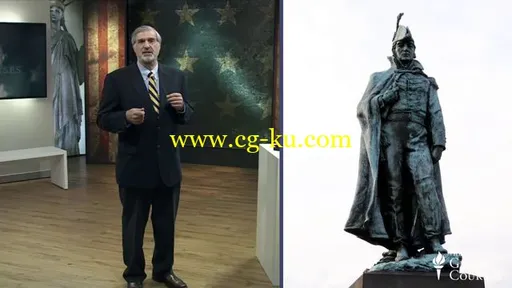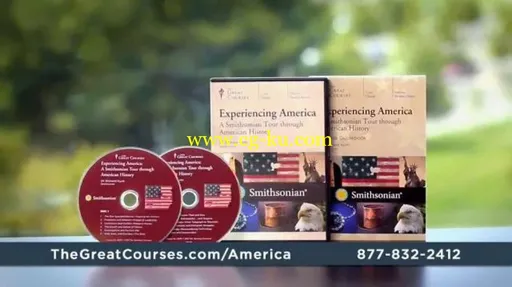
TTC - Experiencing America By Professor Richard Kurin Ph.D.
WEPRip | M4V/AVC, ~1382 kb/s | 640 x 360 | English: AAC, 128 kb/s (2 ch), 44.1 KHz | 8.14 GB
Genre: History
The Smithsonian is a repository of America’s history, achievements, aspirations, and identity. It holds the artifacts of great leaders, and those of ordinary Americans. It houses scientific specimens and technological wonders. It is home to art, music, films, writings—a vast treasure trove of objects of extraordinary beauty and outstanding design. With a collection of some 137 million items in more than two dozen museums and research centers, the Smithsonian brings our national epic to life as nothing else can.
Consider these examples of its riches:
George Washington’s simple but elegant army uniform and sword;
Thomas Jefferson’s Bible, which he compiled by hand so he could study the Gospels in four different languages;
The chairs where Generals Lee and Grant sat when they concluded the surrender that ended the Civil War;
Jacqueline Kennedy’s stunning silk gown, worn at the inaugural balls for President John F. Kennedy; and
The spacesuit that protected Neil Armstrong when he took his “one small step” on the Moon.
Such outstanding holdings are the reason a tour of the Smithsonian museums is an American tradition—a pilgrimage made by 31 million visitors every year. They come to be enthralled, to be moved, and above all to learn—motivated by the institution’s mission to promote the increase and diffusion of knowledge.
That worthy goal is also the purpose of The Great Courses, and it has inspired a unique partnership: The Great Courses and the Smithsonian are collaborating to bring the Smithsonian museums to you. In an unprecedented move, curators have taken objects out of their cases and brought them to our lecture room to give you special access to treasures that collectively represent the American experience.
Experiencing America: A Smithsonian Tour through American History showcases 20 authentic historic objects along with detailed replicas and photographs of almost 100 other artifacts and exhibits. Together, these evocative items tell the story of America, its people, and its diverse cultures in 24 lavishly illustrated half-hour lectures.
Your guide is the distinguished scholar, administrator, and bestselling author, Dr. Richard Kurin, Under Secretary for History, Art, and Culture at the Smithsonian. Among his many responsibilities, Dr. Kurin oversees most of the Smithsonian’s national museums, libraries, and archives, making him the curator of the country’s greatest treasures—and the ideal host for this remarkable survey.
A History Course Like No Other
In addition to historic objects, Experiencing America includes maps, portraits, recordings, videos, and demonstration models. The result is an American history course like no other. Along with history, you get a behind-the-scenes look at the work of curators, conservators, and other professionals who are preserving our nation’s heritage.
Experiencing America is ideal preparation for anyone planning to visit the Smithsonian. And for those who can’t make the trip, this course brings the Smithsonian to you, providing an immensely rewarding twelve-hour journey through the past. It starts more than 15,000 years ago with some of the oldest human artifacts found in North America. Your tour continues to Plymouth Rock, the Pacific Northwest with Lewis and Clark, the Moon and back, and even to the Land of Oz, thanks to Dorothy’s famous ruby slippers worn by Judy Garland in the 1939 movie.
The showpieces of the course are a selection of original artifacts, which Dr. Kurin presents after donning a pair of archival gloves. These historic treasures include:
Star-Spangled Banner: Dr. Kurin shows and discusses a fragment of the renowned flag that inspired Francis Scott Key to write the national anthem. The original flag measured 30 by 42 feet and is now on display at the National Museum of American History.

Slave shackles: The new National Museum of African American History and Culture has a pair of iron shackles that were used to restrain enslaved Africans on their ocean passage to America. The set held by Dr. Kurin is unusually small because it was worn by a child.
Bell telephone: Dr. Kurin demonstrates how an early cup-shaped telephone was used as a transmitter by speaking into it and as a receiver by then holding it to the ear. Along with many other inventions, it resides in the National Museum of American History.
Sitting Bull's drawing book: The victorious Indian chief at the Battle of Little Big Horn made a book of drawings that depict his deeds as a warrior. This fascinating set of sketches is housed at the National Museum of Natural History.
Apollo 8 glove: The first humans to travel beyond Earth’s orbit were the three astronauts who orbited the Moon aboard Apollo 8 in 1968. Dr. Kurin shows a spacesuit glove worn by one of them. It resides in the National Air and Space Museum.
And Dr. Kurin brings out more than a dozen other original items, each telling an exceptional story.
Nearly Limitless Treasures
Many people are surprised by the number of facilities that comprise the Smithsonian—from the museums lining the National Mall, such as American History, Natural History, American Indian, Air and Space, and African American History; to those beyond, including the National Portrait Gallery, National Zoo, American Art Museum, and the Cooper-Hewitt, Smithsonian Design Museum.
Experiencing America draws on all of these resources and more. For example, from the National Museum of American History, you focus on such items as these:
Sutter’s Mill gold flake: Weighing less than 0.09g, this tiny gold flake found at a California sawmill in 1848 launched the California Gold Rush—a great wave of migration that opened a momentous new chapter of American history.
Lincoln’s hat: Our tallest president, Abraham Lincoln, liked to wear a stovepipe hat that increased his height even more. Tragically, the hat in the Smithsonian’s collection was worn by Lincoln on the night of his assassination at Ford’s Theater.
Bugle from USS Maine: The Spanish-American War was incited by the mysterious explosion of the U.S. warship Maine in Havana harbor in 1898. Among the recovered artifacts, the Smithsonian has a bugle, possibly the one playing “Taps” moments before the blast.
Berlin Wall fragment: The Cold War that pitted the Soviet bloc against the democratic West lasted from 1945 until 1989, when the symbol of communist tyranny, the Berlin Wall, was dismantled by protestors. The Smithsonian has a piece.
Julia Child’s kitchen: When renowned chef Julia Child retired in 2001, the Smithsonian acquired her kitchen—sink and all! The meticulously recreated room is popular with cooking enthusiasts, who admire its well-equipped but homey character.
From the National Museum of Natural History, you learn the story of Martha, the last surviving passenger pigeon, who died in 1914. You also chart the glittering career of the Hope Diamond, which arrived at the Smithsonian in 1958 inside an ordinary U.S. Mail parcel like the one Dr. Kurin proudly displays.

He also shows Marian Anderson’s mink coat, which is in the collection of the Anacostia Community Museum. A virtuoso African-American singer, Anderson wore the coat for a celebrated 1939 performance that took place on the National Mall when she was denied a concert hall in segregated Washington, D.C. You also see portraits from the National Portrait Gallery, including those of Pocahontas, George Washington, and Frederick Douglass.
Among the objects you explore from the National Museum of the American Indian is a towering totem pole carved by a contemporary Native American artist. And you discover that the Cooper-Hewitt, Smithsonian Design Museum on Manhattan’s upper east side is itself an artifact—the mansion of steel baron turned philanthropist Andrew Carnegie.
The treasures are almost limitless, and so is the deeper insight you gain into American history. But the most moving moment in Experiencing America comes when Dr. Kurin turns to relics from the terrorist attacks of September 11, 2001. The objects include a crash-scarred logbook owned by a flight attendant aboard one of the hijacked airliners; the crumpled door of a New York City fire engine, found in the rubble of the World Trade Center; and a fireman’s crowbar, also recovered from the site.
“Simple object, but part of a big story,” reflects Dr. Kurin. “And when you’re in intimate proximity to one of these objects, as I am now, you have a link to that sweeping story. History is not distant. It’s not a stranger.”
Includes:
1 The Star-Spangled Banner -
Inspiring
the Anthem
2 Presidents and Generals - Images of Leadership
3 Conscience and Conflict - Religious History
4 The Growth and Spread of Slavery
5 Emancipation and the Civil War
6 Gold, Guns, and Grandeur - The West
7 The First Americans - Then and Now
8 Planes, Trains, Automobiles and Wagons
9 Communications - From Telegraph to Television
10 Immigrant Dreams and Immigrant Struggles
11 User Friendly - Democratizing Technology
12 Extinction and Conservation
13
Kitty
Hawk to Tranquility - Innovation and Flight
14 Cold War - Red Badges, Bombs, and the Berlin Wall
15 National Tragedy - Maine, Pearl Harbor & 9/11
16 For the Greater Good - Public Health
17 Women Making History
18 The Power of Portraits
19 Two Centuries of American Style
20
Hollywood
- The American Myth Machine
21 The Hope Diamond - America's Crown Jewel
22 Sing Out for Justice - American Music
23 Exploring the Land, Exploring the Universe
24 All Men Are Created Equal - Civil Rights
More Info:
Here

发布日期: 2014-10-13